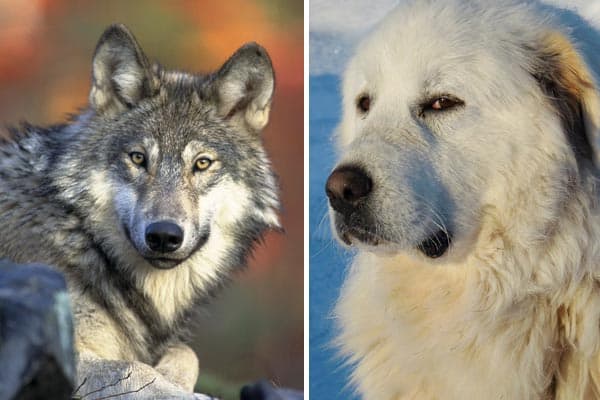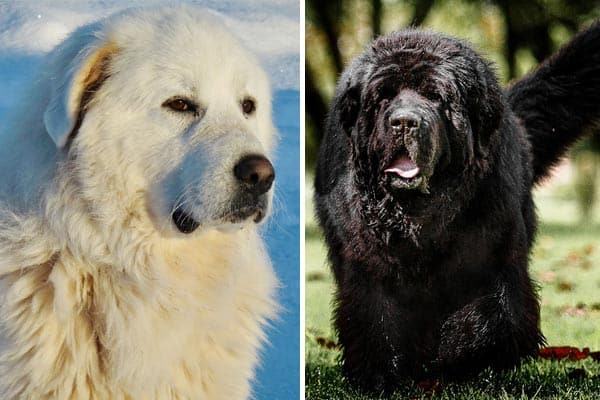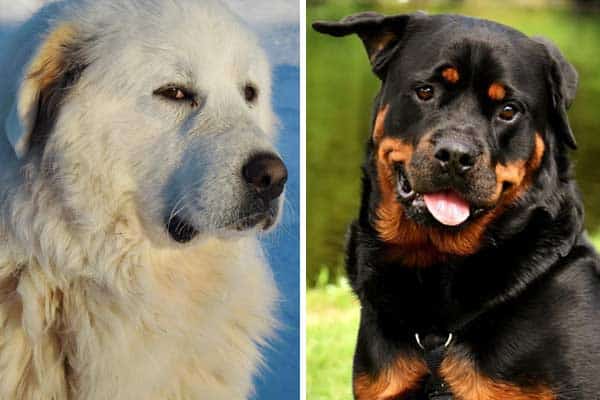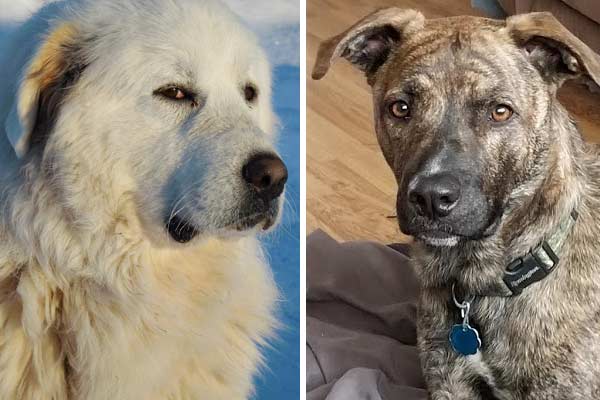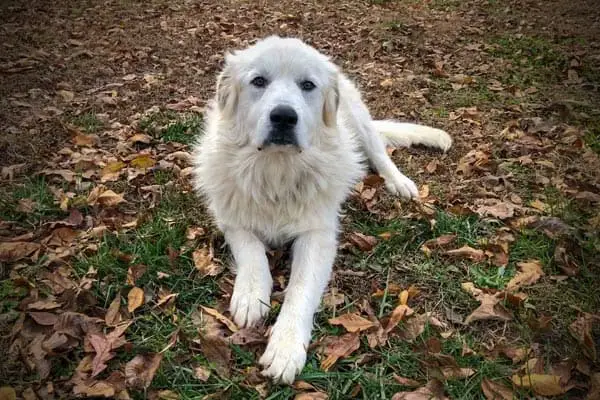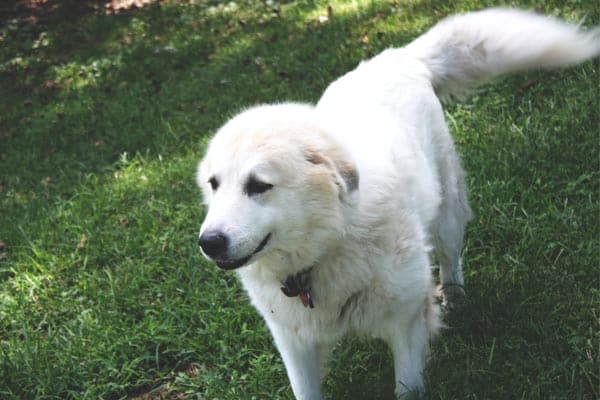Great Pyrenees vs Bernese Mountain Dog: More Different than Alike
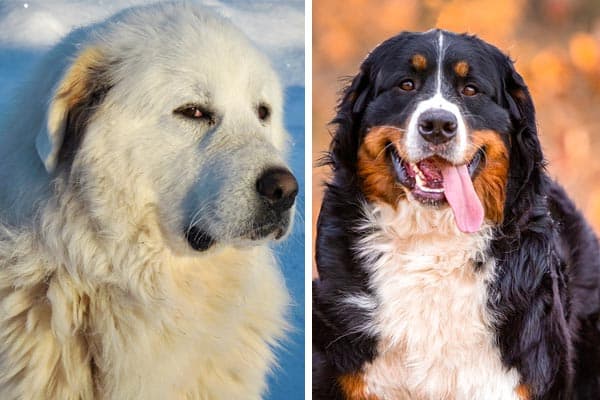
When you compare breeds, the large mountain dogs naturally come to mind. The Great Pyrenees and Bernese Mountain Dog look like color variations of the same dog on the surface.
You might even argue that they only differ because one evolved in the Pyrenees Mountains while the other developed in the Alps. A closer inspection reveals they have more differences than similarities.
The Great Pyrenees vs Bernese Mountain Dog is a livestock guardian as opposed to a more generic farm dog.
You cannot mistake the two breeds, as the Great Pyrenees is a large white dog of medium substance from France and Spain while the BMD is a Swiss, tricolor worker of significant bone composition and shorter height.
Both have dense thick coats for frigid weather but have differences in body and head conformation, expression, temperament, activity, and trainability.
The Great Pyrenees vs Bernese Mountain Dog History
Both the Great Pyrenees and Bernese Mountain Dog started out in European mountain ranges but in separate areas.
Great Pyrenees
As the name would indicate, the Great Pyrenees developed in the Pyrenean Mountains on the French side. Fossil records indicate they have been in existence since at least 1800 BC.
Theories hypothesize the Great Pyrenees arose from white Asian mountain dogs that had migrated with their shepherds into the area.
The Tibetan Mastiff, Kuvasz, and Italian Maremma Sheepdog likely also had important roles in the ancestry of the Great Pyrenees.
Great Pyrenees guarded sheep against predators and would-be human thieves. The large dogs would eventually gain the high regard of such royalty as King Louis XIV, who used them to guard his abode in the 1670s. However, they had been guarding French castles since the 1400s.
Great Pyrenees helped save the St Bernard breed in the 1870s but then required a rescue of its own from extinction in the early 1900s. The Great Pyrenees would not receive AKC recognition until 1933 despite arriving in the US in 1824.
Bernese Mountain Dog
The history of the Bernese Mountain Dog uncannily parallels that of the Rottweiler. Historians believe they were the byproduct of dogs that migrated with Roman soldiers into the Bern area of the Swiss Alps around 20 BC.
Bern, Switzerland is a dairy region, and the BMD had responsibilities such as driving cattle, hauling heavy equipment and products, pulling carts, and guarding the land.
Machinery drove them to near-disappearance in the early 1900s. A Bernie enthusiast, Albert Heim, revived the breed by reawakening awareness among farmers around 1907.
The first BMD pair made it to Kansas in the US in 1926 and AKC acceptance was quick, instating the breed as a working dog in 1937.
Vast Differences in the Great Pyrenees vs Bernese Mountain Dog Breed Standard
Physical Features
Size
Male Great Pyrs are 28 to 32 inches tall at the shoulders and weigh 110 to 160 pounds. Females are smaller, ranging from 26 to 29 inches tall and weighing 80 to 120 pounds.
Bernese Mountains Dogs are 23 to 28 inches tall and weigh 75 to 120 pounds. Females are typically two inches shorter than males and weigh five to twenty pounds less.
Head
The Great Pyrenees head shape is a slight wedge with a muzzle and skull of equal lengths and a slightly rounded crown. With the correct proportions, the Great Pyrenees should have a gradually sloping stop.
The eyes are almond-shaped and dark, and the ears should be small or medium in size. A Great Pyr’s ears are set at the level of the eyes and are V-shaped except for the rounded tips.
Several sources like the GPCA speak of a line comprised of opposing hairs from the upper and lower halves of the face. This line runs from the outer corner of the eye back to the ear.
Overall, the Pyrenees should have an intelligent, pensive, and dignified expression which is as important as the proportions of the head.
A BMD should have a head that is flat and broad on top with high-set ears. The ears are triangular and medium-sized with rounded edges.
A Bernie has oval-shaped eyes and an intelligent and spirited yet kind and gentle expression. Bernese Mountain Dogs have well-defined stops compared with the Great Pyrenees, and you will see a furrow down the forehead. Neither stop nor furrow should be extreme.
A BMD should have a straight muzzle and dark nose and eyes. With its tight and thin flews, Bernese Mountain Dogs do not drool like the Great Pyr.
Neck
Both breeds have a powerful and muscular neck of medium length. The great Pyrenees’ neck is a few inches thicker than the BMD.
Body
Each dog has a broad and deep chest and a wide strong back. Bernies appear broader in both the chest and back.
The Great Pyrenees has a croup with a gradual slope while the BMD’s is more rounded. Each dog has a level topline and low-set tail.
The Great Pyrenees has a plumed tail and often carries it over the back in a complete wheel when alert or working. A BMD has a bushy tail that the dog will carry high and curled at the end in excitement but never over the back.
Limbs
As working dogs, both the Great Pyr and the Bernie have tight-fitting laidback shoulders and powerful and straight legs. The hindquarters are muscular.
Great Pyrenees have toed-out hindfeet which are characteristic of the breed. They must have double rear dewclaws. The Bernese Mountain Dog has all feet facing forward, and the rear dewclaws must be removed.
Great Pyrs have rounded feet with arched toes, and the BMD’s paws are compact.
Great Pyrenees dogs move with smoothness, efficiency, and elegance. Their strides, although powerful and far-reaching, should appear effortless.
Bernies have an efficient, no-frills gait with power from the hindquarters and good reach in the front. Bernies move with deliberation unless there is sufficient cause to quicken their steps.
Similarities in Coats of the Great Pyr and Bernese Mountain Dog
The Great Pyrenees and Bernese Mountain Dog are both double-coated. They shed continuously with copious loss of undercoat hairs in the spring and summer.
A Pyrenees’ outer coat is long, flat, and straight or slightly wavy. The undercoat is made up of fine, dense wool. Both coats together make for a weather-resistant shield.
A Great Pyrenees should have a ruff of longer and thicker fur around his neck and shoulders along with feathering on the backs of the legs and plumes on the tail.
The Bernie’s coat is neither as luxurious nor quite as long as the Pyrenees. However, its shaggy texture makes it more difficult to keep up. Bernese Mountain dogs can have straight or wavy fur and the undercoat is dense wool.
Great Pyrenees dogs can withstand much colder temperatures than the Bernese and are a little more tolerant of the heat.
Where the Pyrenees needs brushing three times a week, the Bernese requires daily, or every other day brushing to maintain her coat’s sheen and keep it from tangling.
Great Pyrenees vs Bernese Mountain Dog coloring is like day and night.
Coloring is where the Great Pyr and Bernese differ most clearly upon a quick glance.
Great Pyrenees are white. They can be solid white or have a tan, badger, red, or gray markings that do not occupy more than a third of the coat. Many times, the markings are located only on the ears or face.
Bernese Mountain Dogs are tricolor. They are mostly black with rust and white marking in stereotypical patterns.
Temperament of Great Pyrenees vs Bernese Mountain Dog
Our temperament descriptions assume well-socialized dogs.
The Great Pyrenees is affectionate, confident, courageous, strong-willed, independent, patient, and protective. She is naturally suspicious of unfamiliar people.
Bernies are faithful, somewhat clingy, loving, loyal, and intelligent.
Because of their independence and the work they were bred to do, Great Pyrenees tend to be more difficult to train than Bernies.
However, Bernese Mountain Dogs are very sensitive, and a harsh word or sideways look can set back their training by weeks.
Neither dog is a first-rate guard dog, but the Great Pyrenees tends to be more protective and a more vigilant watchdog. Bernese Mountain Dogs can be territorial.
Great Pyrenees are prolific barkers and are usually nocturnal. Bernese Mountain Dogs bark an average amount and will be active during the day with you.
Pyrs are destructive without enough mental stimulation or a job to do while Bernies are more apt to tear things up if you leave them alone.
Both breeds require extensive socialization as puppies. Unsocialized Great Pyrs can become unapproachable and prone to indiscriminate aggression. Bernese Mountain Dogs become shy or timid with insufficient socialization. They may bite out of fear.
Both breeds tend to be protective towards children of the household. Neither has a proclivity to herd kids, but their large size bears using extra caution with young ones under five years old.
The Great Pyrenees and Bernese are gentle, calm, and well-mannered around most kids. Teaching children proper canine etiquette is paramount to fostering smooth relationships between child and dog.
Neither breed has a propensity to chase small animals, but an unsocialized Great Pyrenees can be overprotective of its flock or human family against other dogs. Bernies are amiable with their fellow canids.
Great Pyrs and Bernies have similar exercise requirements
As big as they are, the Great Pyrenees and Bernese Mountain Dog can live happily with 20 to 35 minutes of exercise a day.
You should add mental enrichment in the form of training and bonding games, but these dogs do not need much physical activity. Bernese Mountain Dogs tend to be more active than the Great Pyrenees.
They may not need much exercise, but both breeds have the stamina to accompany you hiking and other activities. Be mindful of the heat.
Health of Great Pyrenees vs Bernese Mountain Dog
The great Pyrenees is generally healthier than the Bernese Mountain Dog. The Great Pyrenees live an average of 10 to 12 years while Bernies only live six to eight years.
Great Pyrenees Health Problems
- Entropion – eyelids roll inward
- Bloat – stomach can distend and twist; needs surgery; also known as GDV
- Hip dysplasia – lower occurrence than Bernie
- Addison’s disease – affected dog does not produce enough steroids for daily functions
- Luxating patellas – “floating kneecap”
- Cancer – bone
- OCD – abnormal defects in cartilage
Bernese Mountain Dog Health Issues
- GDV (gastric dilatation and volvulus)
- Cancer – bone, spleen, histiocytosis (proliferation of WBCs), and lymph system
- Hip dysplasia
- Von Willebrand’s disease – clotting disorder; affected dog bleeds profusely even with minor events
- Panosteitis – inflammation, and pain in long bones of the growing dog
- Liver shunt
- Elbow dysplasia
- Progressive retinal atrophy – dog eventually becomes completely blind
- Epilepsy – seizure not due to toxins or disease
Great Pyrenees vs Bernese Mountain Dog in Motion
This is an excellent example of a working BMD. Pulling carts is one of the breed’s talents.
This dog is classically marked with rust in all the correct areas and white well-delineated and not expanding into faulted parts like past the paws.
When you see the Great Pyrenees, you will note this dog’s broader appearance, wider head, differences in the set of the ears and carriage of the tail, and eagerness to please.
The Great Pyrenees is being introduced to his job. Of course, you first notice the white base coloration, and this dog has light tan markings.
Note how both breeds have medium-sized eyes, but the Pyr’s appear larger because of his narrower face.
The Great Pyrenees has a thicker, longer coat and he carries his tail in the obligatory wheel.
